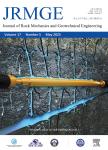版权所有:内蒙古大学图书馆 技术提供:维普资讯• 智图
内蒙古自治区呼和浩特市赛罕区大学西街235号 邮编: 010021

作者机构:College of Engineering and AviationSchool of Engineering and TechnologyCQUniversityMelbourneVIC 3000Australia Institute of InnovationScience and Sustainabilityand Future Regions Research CenterFederation UniversityChurchillVIC 3842Australia Department of Infrastructure EngineeringFaculty of Engineering and Information TechnologyThe University of MelbourneParkvilleVIC 3010Australia School of Architecture and Civil EngineeringThe University of AdelaideAdelaideSA 5005Australia School of HealthMedical and Applied SciencesCQUniversityRockhamptonQLD 4701Australia
出 版 物:《Journal of Rock Mechanics and Geotechnical Engineering》 (岩石力学与岩土工程学报(英文版))
年 卷 期:2024年第16卷第7期
页 面:2801-2812页
核心收录:
学科分类:081401[工学-岩土工程] 08[工学] 0814[工学-土木工程]
基 金:supported by an Australian Government Research Training Program(RTP)scholarship
主 题:Soil stabilization High plasticity clay Biopolymer dosage Hydrated lime Curing time Unconfined compressive strength(UCS)
摘 要:This study investigates the efficacy of sodium alginate(SA),xanthan gum(XG),guar gum(GG)and chitosan(CS)d each applied at five different solid biopolymer-to-water mass ratios(or dosages)and cured for 7 d and 28 d d on the unconfined compressive strength(UCS)performance of a high plasticity clayey ***,on identifying the optimum biopolymer-treatment scenarios,their performance was compared against conventional stabilization using hydrated *** a given curing time,the UCS for all biopolymers followed a riseefall trend with increasing biopolymer dosage,peaking at an optimum dosage and then subsequently decreasing,such that all biopolymer-stabilized samples mobilized higher UCS values compared to the unamended *** optimum dosage was found to be 1.5%for SA,XG and CS,while a notably lower dosage of 0.5%was deemed optimum for ***,for a given biopolymer type and dosage,increasing the curing time from 7 d to 28 d further enhanced the UCS,with the achieved improvements being generally more pronounced for XG-and CS-treated *** of the investigated biopolymers was able to produce UCS improvements equivalent to those obtained by the 28-d soilelime samples;however,the optimum XG,GG and CS dosages,particularly after 28 d of curing,were easily able to replicate 7-d lime stabilization outcomes achieved with as high as twice the soil’s lime ***,the fundamental principles of clay chemistry,in conjunction with the soil mechanics framework,were employed to identify and discuss the clayebiopolymer stabilization mechanisms.